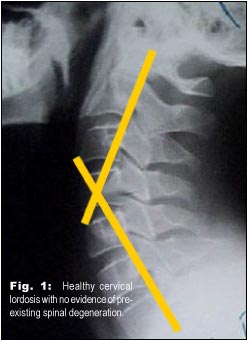Science, Posture and Personal Injury
by Dr. Mark R. Payne D.C.
Personal injury patients inevitably present with a unique set of challenges. From a clinical standpoint they are often in more acute, severe pain. Pre existing conditions are extremely commonm and need to be taken into account. Finally, there will almost always be real and legitimate concerns related to any number of “third” parties involved in the chiropractic-legal process. Obviously, the patients have needs and priorities related to their physical health and well being, but building the successful PI practice is often dependent upon the doctor’s ability to fairly meet the legitimate concerns of all parties involved.
I wanted to take this opportunity to discuss some of the scientific literature relevant to postural rehabilitation of the personal injury case. If you intend to step into the chiro-legal arena, it’s vital that you understand what the scientific literature does and doesn’t support. Proper documentation of your rationale for treatment is always of primary concern. In personal injury cases, it is doubly important. Here’s a brief overview of some of the literature available to back you up, should you decide to include postural rehab as a part of your treatment program.

First, the good news:
• There are now several studies indicating that significant disruption of the normal spinal curves is associated with spinal pain and/or headache of cervical origin (Spine ’94, JSD ’98, JMPT ’92, HA ’93).
• Loss of the cervical lordosis has been shown to be a common result of cervical trauma (Spine ’97, SAMJ ’78, JBJS ’63).
• It’s possible to objectively analyze the patient’s postural status using simple, geometric radiographic analysis (See Figs. 1 & 2). These methods have shown a very high degree of both inter and intra examiner reliability in several studies (JMPT ’93, ’92,’95,’98,’03).
• There is also good evidence in the literature to support the need for healthy spinal curves to prevent future onset of problems (JBS ’74, JMPT ’02).
• Finally, we now have proven effective methods of restoring both the cervical and lumbar lordosis. Including postural exercise and traction procedures puts you on firm ground should someone question your methods (APM/R ’04,’02). My point is that radiographic analysis of the patient’s posture is simple, straightforward, and reliable. Such analysis of spinal imbalance is well documented and easily understood by patients and attorneys alike. Simple biomechanical analysis should be a basic part of your work up on every PI patient.
Now for the bad news:
• Many doctors in the field continue using poorly documented methods of X-ray analysis, IF they even bother to measure the X-rays at all. The profession has become so oriented toward “functional” based care that many doctors give little more than passing notice to postural imbalance and fail to document what is often strong prima facie evidence of injury.

• Many doctors continue to use advanced spinal degeneration as justification for questionably long periods of “corrective” care programs often consisting of little more than adjustments or passive therapy. With the exception of one small study which suggests considerable improvement with Activator® Methods (JMPT ’03), there is little evidence that spinal adjustments do very much to improve spinal structure. At this point, postural exercise and traction procedures appear to be the most effective tools for improving patient posture.
• Many doctors are using effective traction and exercise methods to address postural imbalance but making excessive recommendations for care based on erroneous advice from their practice managers or technique gurus. I want to be very clear about my position on this. Just because some particular method appears effective over a given trial period, there is no indication that further treatment will continue to produce improvement at the same rate. In fact, almost any treatment program will reach a point of diminishing return. One popular seminar continues to teach that, if twelve weeks of care is good, then thirty-six weeks must be three times as good. There’s certainly no evidence to support such long programs of care, most of which conveniently include an expensive series of adjustments of little or no proven value.
Such long programs of care are naïve at best and grossly irresponsible at worst. I mention it here because many well meaning doctors are hanging their reputations on such questionable logic. Prolonging care for PI patients beyond that necessary to return them to their pre injury status is not only unfair to third party payors, it’s actually counterproductive in the long run to building a successful PI practice. Building your reputation in the PI arena revolves largely around three basic things: using solid, well documented methods of analysis and treatment, returning the patient to pre injury status as quickly as possible, and keeping professional fees to a level every one involved can live with. Attention to those simple details will likely improve your standing in the community as an ethical doctor who deals fairly with all parties involved.
Dr. Mark Payne is the president of Matlin Mfg., a manufacturer and distributor of postural rehab products since 1988. A full unabridged version of this article with full literature citations is available at www.Matlinmfg.com. To learn more about reliable methods of X-ray analysis, call 1-334-448-1210 for a Free Report, The Best Corrections of Your Career: Measurement of the Lateral Radiographs.*
*Special thanks to Dr. Roger Coleman of Coleman Consulting, Othello, WA, for helping with scientific references.
